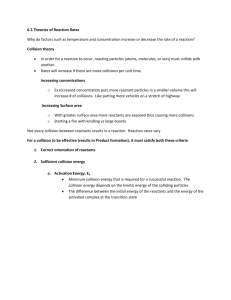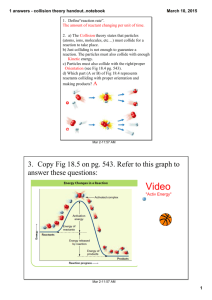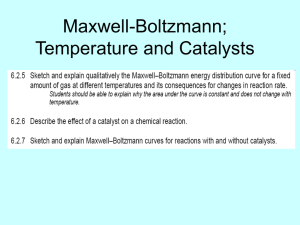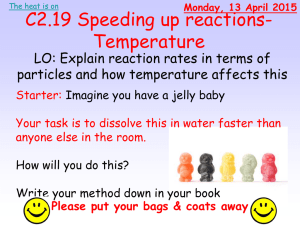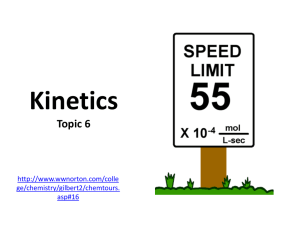Reference: The Collision Theory of Reaction Rates
advertisement
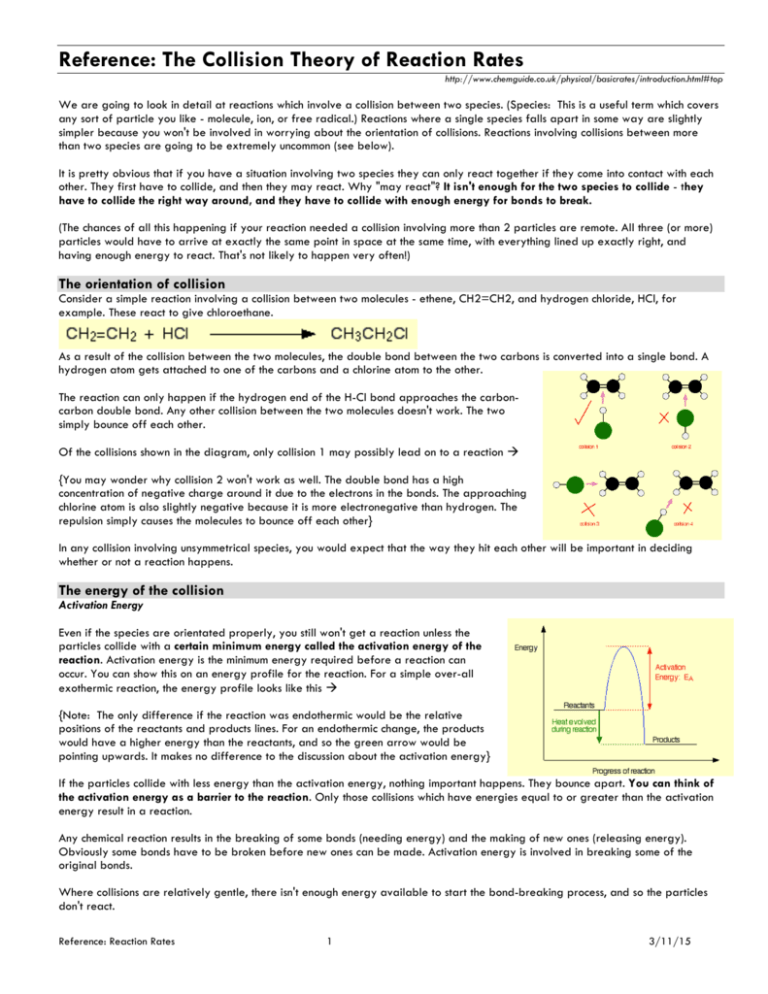
Reference: The Collision Theory of Reaction Rates
http://www.chemguide.co.uk/physical/basicrates/introduction.html#top
We are going to look in detail at reactions which involve a collision between two species. (Species: This is a useful term which covers
any sort of particle you like - molecule, ion, or free radical.) Reactions where a single species falls apart in some way are slightly
simpler because you won't be involved in worrying about the orientation of collisions. Reactions involving collisions between more
than two species are going to be extremely uncommon (see below).
It is pretty obvious that if you have a situation involving two species they can only react together if they come into contact with each
other. They first have to collide, and then they may react. Why "may react"? It isn't enough for the two species to collide - they
have to collide the right way around, and they have to collide with enough energy for bonds to break.
(The chances of all this happening if your reaction needed a collision involving more than 2 particles are remote. All three (or more)
particles would have to arrive at exactly the same point in space at the same time, with everything lined up exactly right, and
having enough energy to react. That's not likely to happen very often!)
The orientation of collision
Consider a simple reaction involving a collision between two molecules - ethene, CH2=CH2, and hydrogen chloride, HCl, for
example. These react to give chloroethane.
As a result of the collision between the two molecules, the double bond between the two carbons is converted into a single bond. A
hydrogen atom gets attached to one of the carbons and a chlorine atom to the other.
The reaction can only happen if the hydrogen end of the H-Cl bond approaches the carboncarbon double bond. Any other collision between the two molecules doesn't work. The two
simply bounce off each other.
Of the collisions shown in the diagram, only collision 1 may possibly lead on to a reaction à
{You may wonder why collision 2 won't work as well. The double bond has a high
concentration of negative charge around it due to the electrons in the bonds. The approaching
chlorine atom is also slightly negative because it is more electronegative than hydrogen. The
repulsion simply causes the molecules to bounce off each other}
In any collision involving unsymmetrical species, you would expect that the way they hit each other will be important in deciding
whether or not a reaction happens.
The energy of the collision
Activation Energy
Even if the species are orientated properly, you still won't get a reaction unless the
particles collide with a certain minimum energy called the activation energy of the
reaction. Activation energy is the minimum energy required before a reaction can
occur. You can show this on an energy profile for the reaction. For a simple over-all
exothermic reaction, the energy profile looks like this à
{Note: The only difference if the reaction was endothermic would be the relative
positions of the reactants and products lines. For an endothermic change, the products
would have a higher energy than the reactants, and so the green arrow would be
pointing upwards. It makes no difference to the discussion about the activation energy}
If the particles collide with less energy than the activation energy, nothing important happens. They bounce apart. You can think of
the activation energy as a barrier to the reaction. Only those collisions which have energies equal to or greater than the activation
energy result in a reaction.
Any chemical reaction results in the breaking of some bonds (needing energy) and the making of new ones (releasing energy).
Obviously some bonds have to be broken before new ones can be made. Activation energy is involved in breaking some of the
original bonds.
Where collisions are relatively gentle, there isn't enough energy available to start the bond-breaking process, and so the particles
don't react.
Reference: Reaction Rates
1
3/11/15
The Maxwell-Boltzmann Distribution
Because of the key role of activation energy in deciding whether a collision will result in a reaction, it would obviously be useful to
know what sort of proportion of the particles present have high enough energies to react when they collide.
In any system, the particles present will have a very wide range of energies. For gases, this can be shown on a graph called the
Maxwell-Boltzmann Distribution which is a plot of the number of particles having each
particular energy. The area under the curve is a measure of the total number of
particles present. {Note: The reason for this is beyond the scope of this chemistry
course. It is important that you remember that the area under the curve gives a count
of the number of particles even if you don't understand why!}
The Maxwell-Boltzmann Distribution and activation energy
Remember that for a reaction to happen, particles must collide with energies equal to
or greater than the activation energy for the reaction. We can mark the activation
energy on the Maxwell-Boltzmann distribution: Notice that the large majority of the
particles don't have enough energy to react when they collide. To enable them to
react we either have to change the shape of the curve, or move the activation energy
further to the left. You can change the shape of the curve by changing the
temperature of the reaction. You can change the position of the activation energy by
adding a catalyst to the reaction.
Factors that Affect the Chemical Reaction Rate
Reaction Kinetics
http://chemistry.about.com/od/stoichiometry/a/reactionrate.htm
It's useful to be able to predict whether an action will affect the rate at which a chemical reaction proceeds. There are several
factors that can influence the rate of a chemical reaction. In general, a factor that increases the number of collisions between
particles will increase the reaction rate and a factor that decreases the number of collisions between particles will decrease the
chemical reaction rate.
Concentration of Reactants
A higher concentration of reactants leads to more effective collisions per unit time, which leads to an increasing reaction rate (except
for zero order reactions). Similarly, a higher concentration of products tends to be associated with a lower reaction rate. Use the
partial pressure of reactants in a gaseous state as a measure of their concentration.
Temperature
Usually, an increase in temperature is accompanied by an increase in the reaction rate. Temperature is a measure of the kinetic
energy of a system, so higher temperature implies higher average kinetic energy of molecules and more collisions per unit time. A
general rule of thumb for most (not all) chemical reactions is that the rate at which the reaction proceeds will approximately double
for each 10°C increase in temperature. Once the temperature reaches a certain point, some of the chemical species may be altered
(e.g., denaturing of proteins) and the chemical reaction will slow or stop.
Medium
The rate of a chemical reaction depends on the medium in which the reaction occurs. It may make a difference whether a medium is
aqueous or organic; polar or nonpolar; or liquid, solid, or gaseous.
Presence of Catalysts and Competitors
Catalysts (e.g., enzymes) lower the activation energy of a chemical reaction
and increase the rate of a chemical reaction without being consumed in the
process. Catalysts work by increasing the frequency of collisions between
reactants, altering the orientation of reactants so that more collisions are
effective, reducing intramolecular bonding within reactant molecules, or
donating electron density to the reactants. The presence of a catalyst helps a
reaction to proceed more quickly to equilibrium. Aside from catalysts, other
chemical species can affect a reaction. The quantity of hydrogen ions (the pH
of aqueous solutions) can alter a reaction rate. Other chemical species may
compete for a reactant or alter orientation, bonding, electron density, etc.,
thereby decreasing the rate of a reaction.
Reference: Reaction Rates
2
3/11/15
The Effect Of Pressure On Reaction Rates
http://www.chemguide.co.uk/physical/basicrates/pressure.html
This page describes and explains the way that changing the pressure of a gas changes the rate of a reaction.
What happens?
Increasing the pressure on a reaction involving reacting gases increases the rate of reaction. Changing the pressure on a reaction
which involves only solids or liquids has no effect on the rate.
An example:
In the manufacture of ammonia by the Haber Process, the rate of reaction between the hydrogen and the nitrogen is increased by
the use of very high pressures.
In fact, the main reason for using high pressures is to improve the percentage of ammonia in the equilibrium mixture, but there is a
useful effect on rate of reaction as well.
The explanation
The relationship between pressure and concentration
Increasing the pressure of a gas is exactly the same as increasing its concentration. If you have a given mass of gas, the way you
increase its pressure is to squeeze it into a smaller volume. If you have the same mass in a smaller volume, then its concentration is
higher.
You can also show this relationship mathematically if you have come across the ideal
gas equation:
Rearranging this gives:
Because "RT" is constant as long as the temperature is constant, this shows that the pressure is directly proportional to the
concentration. If you double one, you will also double the other.
The effect of increasing the pressure on the rate of reaction
Collisions involving two particles
The same argument applies whether the reaction involves collision between two different
particles or two of the same particle.
In order for any reaction to happen, those particles must first collide. This is true whether
particles are in the gas state, or whether one is a gas and the other a solid. If the pressure
higher, the chances of collision are greater.
both
is
Reactions involving only one particle
If a reaction only involves a single particle splitting up in some way, then the number of
collisions is irrelevant. What matters now is how many of the particles have enough energy
react at any one time.
to
Suppose that at any one time 1 in a million particles have enough energy to equal or exceed the activation energy. If you had 100
million particles, 100 of them would react. If you had 200 million particles in the same volume, 200 of them would now react. The
rate of reaction has doubled by doubling the pressure.
Reference: Reaction Rates
3
3/11/15


